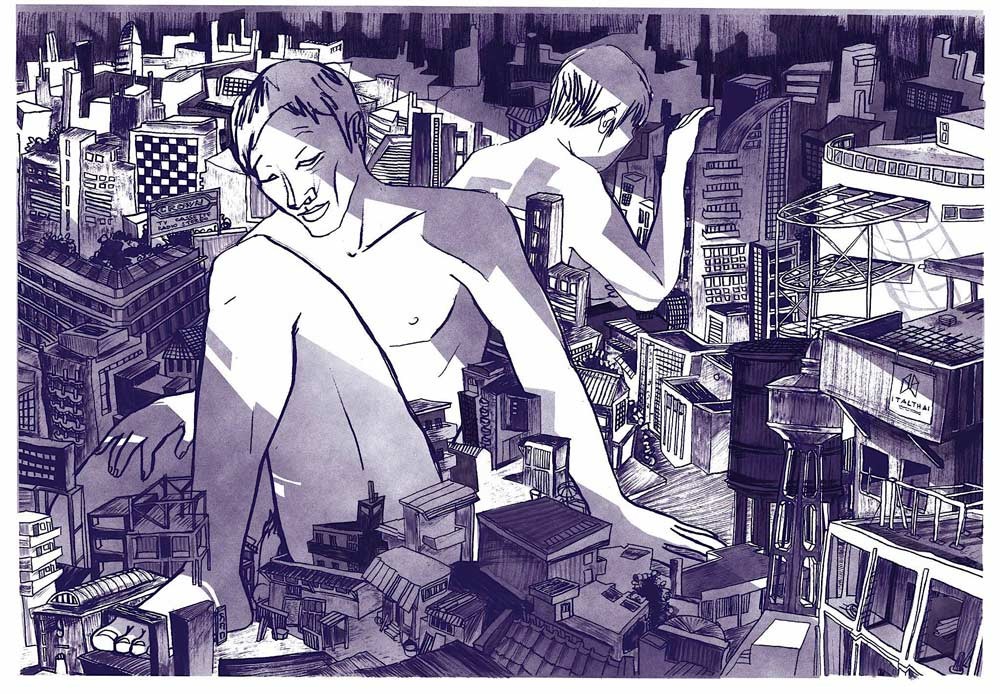The categories “farang,” “Isaan food,” and “cancer” bring to mind preconceived notions about foreigners’ food preferences, their inexperience with spicy flavors, and Northeasterners’ unsafe ways of eating. Of course, these are too simplistic to account for reality. The tongue-in-cheek question in the title is not meant too seriously. What should be taken seriously, though, is how generalizations like “farang is unfamiliar with hot and spicy food” or “Isaan food gives you cancer” or “Isaan people eat raw food” can do more harm than good. The author, a former testicular cancer patient, investigates these categories through a dialogue with their significant other, interspersed with public health posters in a cancer hospital.
By Peera Songkünnatham
“Ugh, I want naem,” my farang husband sends me a message from the other side of the world.
“I have it all the time,” I brag.
“Ughhh—I love all the carcinogenic food,” he says.
“Now you’re giving me something to write about—’my farang husband likes Isaan food, will he get cancer?’ Can I interview you on the phone?”
“Sure. Just be nice to me, na.”
* * *

Naem contains nitrosamine, a compound that is known to cause stomach and liver cancer. Photo: Ubon Ratchathani Cancer Hospital Food Center
“Why do you love naem so much?”
“I mean I like pickled meat stuff. Because both of my parents grew up on farms and have German heritage, so there’s a lot of German heritage food things they share. Like pickled ham, ham you put in sugar and vinegar, which is not so different from what naem is. So I grew up eating pickled meat, so naem is just another pickled meat for me.”
* * *
“When did you hear about Isaan food as a thing?”
“When we went to New York for the first time. We went to Larb Ubol together, so I think sometime around then was the first time.”
“Do you remember what we ate?”
“Let’s see. I don’t remember the food that well. I remember we had som tam lao and khao niau. I think the som tam lao was spicy, and maybe it had crab in it.”
“What do you think is Isaan food?”
“Pa daek, I guess, is an obvious mark.”
“Do you like pa daek?”
“Yeah.”

Uncooked fermented fish can cause a liver fluke infection and lead to cholangiocarcinoma. Photo: Ubon Ratchathani Cancer Hospital Food Center
“Did you like it the first time?”
“Yeah, because I already liked fish sauce a lot. Do you remember yelling at me to not add so much fish sauce in everything? Yes you remember. I liked it so much that bought the Masterchef fish sauce with mackerel on the label and you hated it so much. So I would just have to use it when you weren’t looking.”
“Hahaha. Are you in the minority of farang who likes fish sauce?”
“I don’t know. My family, we cooked some Thai food even before we left Alaska, and we put fish sauce in things. So I don’t think my family hated it, just that I couldn’t put a lot in.”
“Fish sauce to fermented fish—was it a leap or just another shade?”
“Just another shade.”
* * *

Processed meats and dried chili peppers contain borax, which can cause stomach and liver cancer. Photo: Ubon Ratchathani Cancer Hospital Food Center
“When did you first hear that Isaan food can be carcinogenic?”
“Maybe when we went to that liver fluke conference in Khon Kaen. I mean, I already knew that the burnt things on food are carcinogenic. So, grilled food is carcinogenic, but it’s not like all Isaan food is carcinogenic. But in that conference it was like ‘oh all Isaan food is carcinogenic’ if it has uncooked pa daek in it.”
“And do you believe that?
“No. I guess (laughs). To me it’s carcinogenic in the same way that cigarette is carcinogenic. Like you don’t get lung cancer by smoking one cigarette. So as someone who doesn’t eat pa daek every day, I don’t expose myself too much to it.”

Grilled chicken and grilled Isaan sausage contain heterocyclicamine and polycyclicaromatic hydrocarbon, which can cause breast cancer, intestinal cancer, and prostate cancer. Photo: Ubon Ratchathani Cancer Hospital Food Center
“Are you afraid of cancer?”
“Not really. I think I’m more afraid of HIV than cancer.”
“Why aren’t you afraid of cancer?”
“I don’t know? There isn’t cancer in my family, not really. My family suffers much more from heart disease than it does cancer.”
“What do you think about this idea that Isaan food gives you cancer?”
“Oh, I think it’s dumb (laughs). Sorry. Yeah… I just think there are bigger problems than this, like the outsider perceptions that Isaan people are so uneducated and stubborn that they continue to eat dirty food that gives them cancer. I don’t know. Maybe we don’t need to cure this but we make sure people have jobs and not drink so much that they get liver cancer. Do you get what I mean? I agree with the seemingly leftist idea that if people have unrestricted access to resources they will fix their problems.”

Chewing areca nuts and betel leaves can cause oral cancer, tooth cancer, and gum cancer. Photo: Ubon Ratchathani Cancer Hospital Food Center
“I’ve been wondering if farang food has given me cancer, hehe…”
“…”
* * *
“When you were in Isaan, what Isaan food did you eat?”
“Not many things at all. I wanted to spend my time with you, and you couldn’t constantly be exposed to germs from the outside world, so I just ate the food that your grandmother sent to the house. It was all well-cooked Chinese stir fried dishes because you weren’t allowed to eat fresh vegetables, partially cooked meat or anything spicy.”
“Right, and I couldn’t have fresh vegetables, because the chemotherapy suppressed my immune system. I remember going to the cancer hospital, and all the signs suggested that people should eat fresh fruits and vegetables to prevent cancer, but I already got it somehow, you know? So it wasn’t really helpful.

“Eat fresh vegetables and fruits. Reduce fat intake. Protect yourself from cancer.” Photo: Ubon Ratchathani Cancer Hospital Food Center
* * *
“Why do you have such a high tolerance for chili peppers?”
“I don’t know… Growing up, I would eat a little bit of spicy food with my dad, who eats a lot of spicy food.”
“Does it annoy you when people in Thailand are surprised you can eat spicy food?”
“Yeah, it’s the same thing with anything else about being a farang in Thailand. Because half the time you’re treated like you’re being a toddler, and the other half it’s like you’re a weird thing there. The fact that I can eat spicy food is taken as a sign by other people around me that I’m okay. Like my ability to consume is readily and easily taken as a sign of comfortableness.”
“Mmm, now it sounds like farang and Isaan people have similar struggles, never viewed as equal to other people. You either are a complete outsider, or you are held up as a paragon of virtue to the point of nausea.”
“It’s interesting how much food is tied to identity here. I remember when I was teaching English in Chiang Rai, I would often get told that I was a Thai person because I could eat Thai food. People say that, but it’s a joke in the end, it has a farcical element in it.
Because it’s obvious I can’t be a Thai person. There’s no question, no worry about it. I doubt they would say that to a person from Myanmar, you know what I mean?”
“Well, sometimes I’m not so sure whether I am really Thai either. I am a Thai person. But I don’t really fit with what it means to be Thai, or what it means to be Isaan, for that matter. My stomach always protests after I eat koi dib. And you eat spicy food better than me!”
Glossary of terms:
Farang (ฝรั่ง) – Colloquial term for foreigners, particularly with white skin. It also means guava fruit.
Isaan sausage (ไส้กรอกอีสาน) – Fermented grilled sausages, made from roasted sticky rice, ground pork meat, and pig entrails, short and plump in shape, often eaten with leaves of cabbage, sliced ginger and fresh chili peppers.
Khao niau (ข้าวเหนียว) – Glutinous or sticky rice, prepared by soaking it for several hours before steaming it in a bamboo basket.
Koi dib (ก้อยดิบ) – A raw meat spicy salad made from beef, fish, freshwater shrimps, red ant eggs, snails or freshwater shellfish. Red ants are also sometimes used instead of lime as the acid for the koi.
Naem (แหนม) – Fermented sausages, usually made from pork, but some variations include beef, fish or mushrooms. The raw ingredients are encased in banana leaves, plastic bags or sausage casings and left to ferment for three to five days. Naem is either eaten as a side dish or as an ingredient in various dishes.
Pa daek (ปาแดก) – A pungent traditional seasoning made from fermented fish, also known as pla ra (ปลาร้า) in Thai.
Som tam lao (ส้มตำลาว) – A spicy salad made from shredded unripe papaya, crabs, tomatoes, long beans seasoned with pa daek, lime, sugar and chillies.




